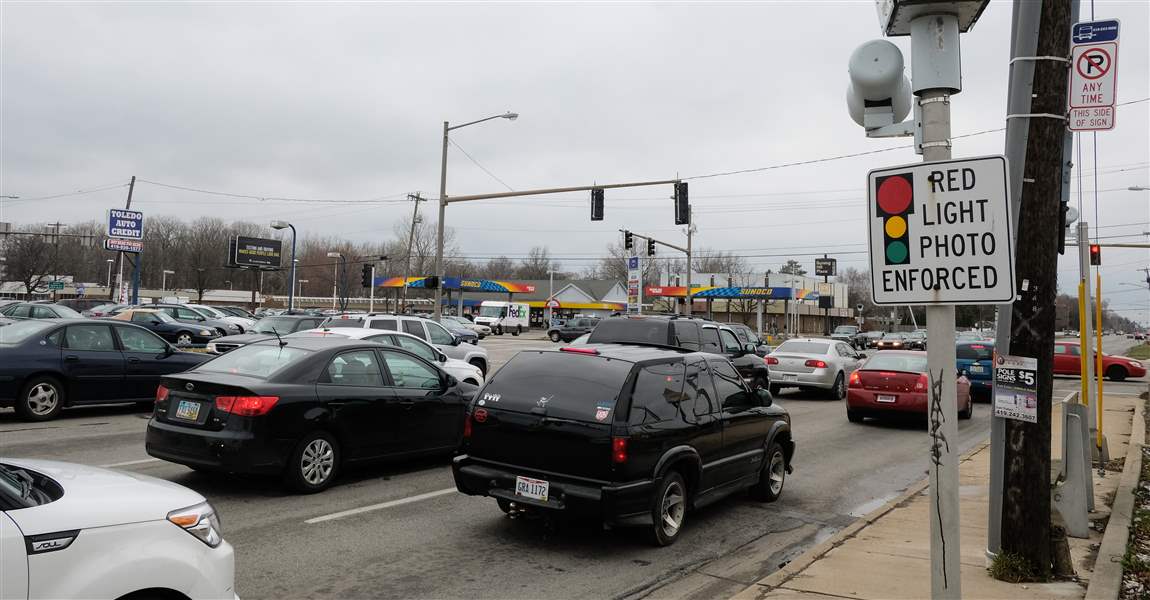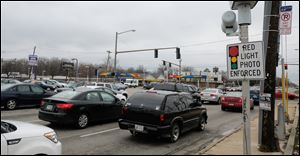
State legislature accused of assault on home-rule
Budget bill latest to limit city powers
5/21/2017
A red light camera is at the intersection of Hill Avenue and Byrne Road in Toledo. A law passed by Ohio lawmakers restricting the use of red light cameras in 2014 is one of several examples of recent home-rule conflicts between the state and its communities.
THE BLADE/JEREMY WADSWORTH
Buy This Image
As Republicans have widened their control over the Ohio General Assembly, bills that seem to chip away at municipalities’ home-rule power have increased.
An amendment introduced in the state budget bill to take away Toledo’s ability to protect children from lead paint poisoning is the latest instance.

A red light camera is at the intersection of Hill Avenue and Byrne Road in Toledo. A law passed by Ohio lawmakers restricting the use of red light cameras in 2014 is one of several examples of recent home-rule conflicts between the state and its communities.
It’s a rising trend from the General Assembly, now dominated by rural and township representatives. And it’s been an ongoing fight.
Examples abound, including 2006 when lawmakers passed a state law prohibiting gun laws that were more restrictive than state or federal law.
“It seems as though the General Assembly and the powers that be at the state level don’t like the local level to have any control,” said state Rep. Teresa Fedor (D., Toledo), whose 45th District is made up entirely of Toledo and Washington Township.
“There’s a concentration of power. There’s a power grab, and they’re breaking our Constitution,” said Ms. Fedor, who moved from South Toledo to East Toledo when the Republican-controlled General Assembly realigned state districts in a 2011 reapportionment.
Republican state lawmakers say there’s nothing nefarious about their legislation that takes away city council powers to make local law.
“Most legislators want to have good relationships with all the local government officials,” said state Rep. Keith Faber (R., Celina) of the 84th House District.
The biggest city in his district is Celina, with about 10,400 residents.
“There are times when there are things of a statewide nature when the legislature decides to act,” Mr. Faber said.
He said if a community “abuses its authority or nonresidents,” then the General Assembly has to act. An example, he said, is when small communities use speed traps to fund local government.
State Rep. Derek Merrin (R., Monclova Township) quietly inserted an amendment in the state budget bill that would give the state sole authority on lead abatement, potentially voiding Toledo’s lead-safe rental law passed last year.
The measure passed the House and is awaiting action in the Senate.
Mr. Merrin in a statement April 28 confirmed he was behind the measure and called Toledo’s lead ordinance “unconstitutional” because it applies the law unequally by applying only to apartment complexes of one to four units.
According to Toledo Law Director Adam Loukx, Mr. Merrin met with Toledo Mayor Paula Hicks-Hudson the day before Mr. Merrin’s amendment became public and did not, at that time, mention his authorship of that provision.
“The mayor was interested in discussing things relating to the city of Toledo, but that didn’t come up,” Mr. Loukx said.
Mr. Merrin, who owns rental property in Toledo, did not agree to a request for an interview from The Blade or respond to written questions.
Birth of home rule

Ohio’s Home Rule Amendment approved in 1912 allowed cities to adopt a charter with a form of government of their own choosing. The amendment was born from a progressive good-government movement.
Toledo quickly accepted the opportunity and adopted a city-manager government, switching in 1993 to a “strong-mayor” form of government.
According to Article 18 of the Ohio Constitution, “Municipalities shall have authority to exercise all powers of local self-government and to adopt and enforce within their limits such local police, sanitary, and other similar regulations, as are not in conflict with general laws.”
At present, the Ohio Supreme Court is deciding whether the Ohio General Assembly improperly stepped on Ohio cities’ rights to operate automated red-light and speed cameras. The Ohio General Assembly in 2015 passed a law restricting automated red-light and speed cameras run by cities like Toledo. Dayton and Springfield are among the cities that are awaiting the court’s decision.
As recently as March, Toledo joined 80 other Ohio cities in a lawsuit challenging Senate Bill 331, passed by the Ohio General Assembly in December.
The lame-duck bill included provisions on many topics including bestiality, cockfighting, and the minimum wage, and contained a section that overrides local laws restricting how pet stores acquire dogs they sell.
Mr. Loukx said municipal home rule is “absolutely” under assault, though he said the municipalities are fighting back.
“We’ve had our fair share of success but had pitfalls as well,” Mr. Loukx said, referring to the fights in the Ohio Supreme Court.
He said two significant losses were the right to require residency of municipal employees and the right to impose tougher restrictions on predatory lending than provided by state laws.
The Supreme Court ruled against Toledo on residency because of a constitutional provision giving the General Assembly power to legislate on behalf of employees throughout the state.
In 2009, the Ohio Supreme Court ruled on a 5-2 vote that residency fell under the state’s power to regulate hours of labor, minimum wages, and the general welfare of all employees. In 2008, the state Supreme Court ruled 4-3 that a ban imposed by the Sandusky County city of Clyde conflicted with Ohio’s concealed-carry gun law.
The Supreme Court sided with municipalities in 2008, ruling that using traffic cameras to enforce speeding and red-light laws was an appropriate use of police powers under the home rule amendment to the state Constitution. That case was based on a citizen lawsuit. In 2007, Republican Gov. Bob Taft vetoed a bill passed by the General Assembly to restrict the cameras. Governor Taft said the bill was an infringement on local home-rule authority.
But a legislature determined to stamp out the cameras came back in 2014 and passed a new law requiring a police officer to be present whenever a camera records a violation — something the city says is impractical. The Republican-controlled legislature returned in 2015 and tacked on a rule that any city failing to comply with its red-light laws loses state funding.
Toledo and other Ohio cities have appealed to the Supreme Court to have the law struck down and are waiting for a ruling.
Mr. Loukx said the threats to home rule are a reason to retain the city’s lobbying contract with Shumaker Advisors LLC, which costs taxpayers $60,000 a year.
State Sen. Matt Huffman (R., Lima) said home rule is embedded in the state Constitution.
“Inevitably there is some conflict along the road where state authority starts and stops. If a city is violating someone’s voting rights, constitutional rights — freedom of speech — and claiming home rule, the legislature has to say, ‘You can’t do that,’ ” he said.
“My problem with speed cameras is that affects a whole lot of people who aren’t part of the city of Toledo,” Mr. Huffman said. “The city can’t simply say we have a charter and we can do what we want.”
Election issue
Home rule has become an issue in the 2018 race for governor. Democratic candidate Nan Whaley, the mayor of Dayton, raised the issue in her candidacy announcement two weeks ago.
Last year, she, along with Mayor Hicks-Hudson and more than two dozen other mayors, created the Ohio Mayors Alliance to present a united front on issues with the General Assembly.
“The disintegration of home rule has been a problem. It’s interesting to me that you have a bunch of people in the Statehouse who claim to be conservatives. The conservative base of their party is that local control is the best, and they’ve systematically taken that apart. It’s very bizarre,” Ms. Whaley said.
Indeed, bills and laws attempting to preempt city ordinances have proliferated when Republicans are in power, but not so much when Democrats hold power.
A quick search of home-rule bills turns up examples from the period before Democratic Gov. Ted Strickland took office in 2007, but few during his four-year term. Democrats controlled the state House of Representatives for one session while he was governor, in 2009 and 2010.
The legislative feasting on home rule resumed when Republican Gov. John Kasich took office in January, 2011.
Kent Scarrett, director of the Ohio Municipal League since March, 2016, agreed that the Republican-controlled General Assembly is a hard sell for municipal priorities.
He counted 30 preemption bills introduced in the last session of the General Assembly.
Urban vs. rural
The Democrats who make up the minority in the House and Senate are overwhelmingly from the state’s urban centers, while Republicans tend to come from rural and suburban townships. Townships, like counties, have limited local powers, looking to the General Assembly for all their legislation.
It’s true for Lucas County, too.
The three House members who represent some or all of Toledo are Democrats — Reps. Michael Ashford of Toledo, Ms. Fedor, and Michael Sheehy, of Oregon.
Lucas County’s fourth state representative, Mr. Merrin of Monclova Township, represents a district with more townships than municipalities.
“Some House districts are just townships. They don’t have any incorporated areas in their district,” Mr. Scarrett said. “In the House there is certainly more of a township-oriented perspective.
“Townships and counties are creatures of statute — the General Assembly really controls every aspect of county and township government. The legislature does not have that same authority over cities and villages.”
While cities may chafe when residency, red-light cameras, “pit-bull” ordinances, zoning, and lead abatement are infringed on by the General Assembly, the threat of centralization of income-tax collection is especially scary.
Not all of the conflicts between the municipalities and the General Assembly involve home rule.
Governor Kasich proposed this session to centralize collection of business income taxes by municipalities to make the process more uniform for the businesses that pay it.
Mr. Kasich’s proposal was to have the state collect the tax, and keep 1 percent of the revenue for its administrative costs.
Mayor Paula Hicks-Hudson testified in Columbus against the plan, just as she did two months later against the lead abatement amendment. It was pulled from the budget, but is expected to return.
“There’s over 600 cities and villages in Ohio that have an income tax, and ideologically some members of the General Assembly have an aversion to the income tax as a source of revenue,” Mr. Scarrett said. “Townships don’t have an income tax. Counties don’t have an income tax. That is part of the conversation here ... [majority leaders in the House and Senate are] Republican and conservative and maybe don’t like the income tax.”
A persistent complaint that Republican lawmakers hear from their rural and suburban constituents is that it’s not fair that they have to pay income tax to cities where they don’t live. Mr. Faber and Mr. Huffman said there is no plan to go after that portion of the income tax.
Contact Tom Troy: tomtroy@theblade.com or 419-724-6058 or on Twitter @TomFTroy.